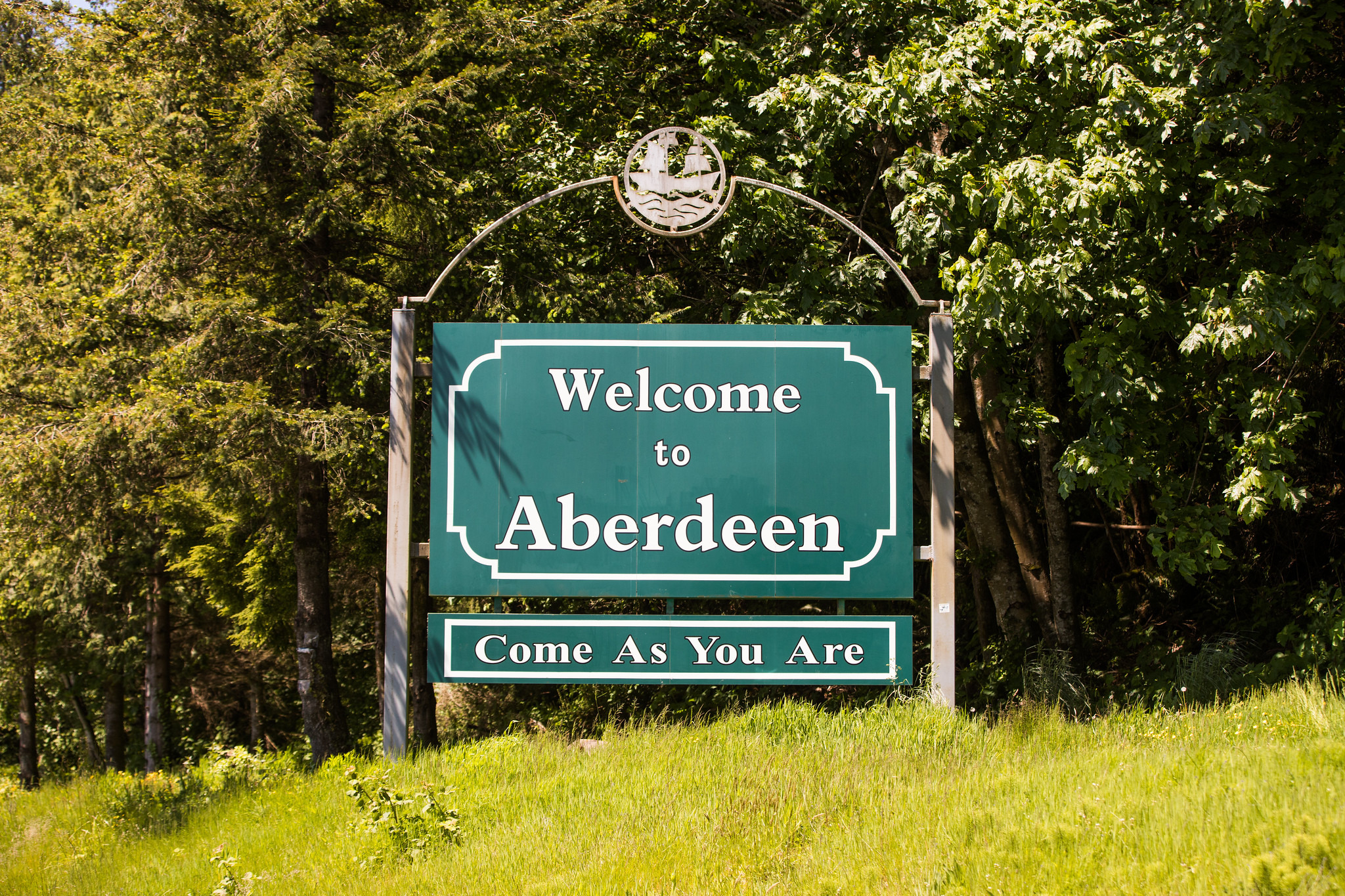
Doused in Mud, Soaked in Bleach
"Welcome to Aberdeen. Come as you are."
The large sign appears on the side of the highway as you round the last bend on the highway into Aberdeen, WA. It's a wholesome Brunswick green, the reassuring colour of governmental initiatives the world over. The lettering is bold and friendly, and the whole thing is topped with a cast-iron sailing ship sailing merrily into a cast-iron bay.
It's hard to imagine what Kurt Cobain would have made of it.
If you're any sort of Nirvana fan, you'll know that Aberdeen is the town where Cobain spent his teenage years. Despite the local council's cheery appropriation of his legacy, the songs that Cobain wrote about the place didn't exactly cast in a particularly flattering light. When you visit, you can understand why.
The drive here has been strange enough — we take the b-roads instead of the highway, and find ourselves winding through thick pine forest that occasionally gives way to glimpses of the coast. We stop for a while on the beach for lunch and watch two kids playing in the shallow grey estuary, their voices echoing across the flat plane of the landscape. In the already diminishing light, the seaboard has a frail briny beauty, the colour of bleached driftwood and lurid seaweed. The water speaks of eels and slime and barnacles and general subaquatic unpleasantness.
An hour further along the road, we pull into a lay-by for a final leg-stretching break and find ourselves looking at an old, clapped-out sawmill. There are machines painted in peeling yellow and sky-blue, sheds with cracked walls, foundations melting into the water. It looks like a engine that someone set running and forgot about, leaving it to wind down slowly to standstill and rust in the salty air of the coast.
The sun is already starting to head down toward the horizon as we reach Aberdeen. A fun fact about the place is that in the early part of the 20th
century it went by the nickname "The Port of Missing Men" because of its
sky-high murder rate. No one could fault you for calling it that today, because while NY Conversation came to town with vague notions of asking locals what they make of the Nirvana industry, 20 years on from Nevermind., this turns out to be impossible: there don't seem to be any locals to ask.
Aberdeen feels almost spookily empty. The population peaked in 1930, in the boom times of the logging industry, before both industry and town were eviscerated by the Great Depression. Today it sits at a smidgeon under 17,000, and none of them appear to be in town on a Saturday afternoon. The shops along the main drag, where we attempt to find coffee, go something like this: something called a "Child Evangelism Fellowship"; an abandoned shopfront; an insalubrious-looking pool hall; an abandoned shopfront; a shop selling "Leather and collectables"; a forlorn sex shop; a place called "Faith Hope Outreach"; a pawn shop; an abandoned shopfront... and a café. Which is closed.
We drive aimlessly for a while and eventually decide to search for the Young St Bridge, under which Cobain famously slept. We find it almost by accident—it's as unassuming a bridge as you'll ever see, crossing the Wishkah with barely a bump. If it wasn't for the guardrails, you could easily drive straight over it and never notice, following the road's long curve into the forest beyond.
The river also curves here, so one riverbank is significantly wider than the other. On the narrower bank, there's a path down to the river, but no real space under the bridge for sitting (or sleeping). Back up toward the road there's a little park, wherein there's a large placard with a portrait of Cobain and the lyrics to "Something in the Way"—surely the only song about homelessness ever to be immortalised on a government-funded billboard—and a curious little plaque set into the ground with a number of Cobain quotes carved into it. As with every other Nirvana memorial in Washington State, there's no mention of his suicide, just his "untimely" or "tragic" death.
Getting down under the other side of the bridge requires climbing over the railing and forging through the undergrowth that grows along the banks of the Wishkah (which are, indeed, muddy). But it's worth the slog, because once you're safely sequestered under the bridge, it feels like being in a cave all your own (albeit one that is today covered entirely with graffiti left by Nirvana fans who've made the pilgrimage here over the years.)
I sit for a while here. It's startlingly beautiful: weeping willows dip down to the slow current, and the water catches the last of the sun in a thousand rippling reflections. The only sounds are the quiet rustle of trees, the quiet music of the river and the rumble of the occasional car passing overhead.
Cobain was 22 when he wrote "Something in the Way". He'd only been able to drink legally in this country for a year. He was a kid, a lost boy. And I find myself thinking just how strange it must have been to go from sleeping under this bridge to global megastardom, from the solitude of this hideaway to the relentless glare of spotlights and crowds of thousands, from being post-industrial penury to being called the voice of a generation. Down here, the myth seems a long, long way away.
Photo, unfeasibly, by someone named Thomas Hawk
Post a comment